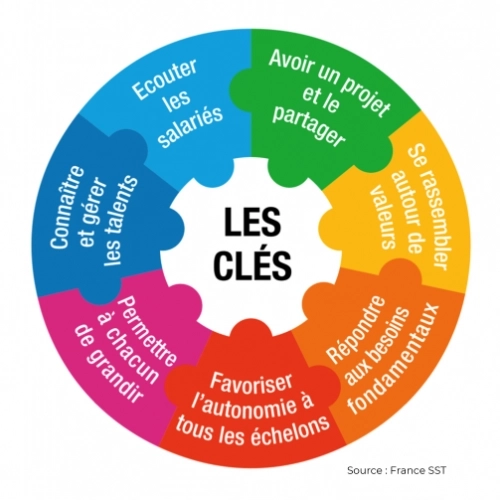
Let's talk about QWL, an acronym you've undoubtedly heard of.
In practice, what is it?
The QWL (Quality of Life at Work) includes actions that allow reconciling the improvement of working conditions for employees and the global performance of companies.
In the current period, issues related to telework agreements are on the agenda of many HR departments, and the quality of life at work is central to negotiations with social partners.
1/ The pillars of QWL
While there are several dimensions of QWL (working conditions, well-being, recognition, degree of autonomy, etc.), when combined, they reflect the spirit of QWL as intended by the negotiators of social agreements (social partners and managers). Thus, each company appropriates and uniquely builds its QWL policy while relying on its founding principles:
- Links between QWL and company performance
- The balance between the objective dimension of working conditions and the subjective size of QWL (well-being perceived collectively and individually)
- The ability of employees to express themselves and act on the content of their work and their working conditions.
2/ Implementation of an efficient QWL policy
QWL policies are multi-faceted and can be challenging to implement, as the interests/constraints of the various stakeholders may diverge. Thus, it is essential to consider the following elements:

- The QWL policy is based on permanent attention to well-being factors and the prevention of PSRs, psycho-social risks.
- The employees' capacity for expression and action is preserved and even reinforced. Employees are experts in their work environment and must therefore be involved in the discussions in this respect.
- The intrinsic content of work and the conditions in which it is performed must be at the heart of improving QWL.
- Relationships are an essential lever for QWL. It must emphasize the development of collective intelligence and the acquisition of new relational skills geared towards cooperation.
- QWL must be part of a broader CSR project to have a positive and lasting impact on the company's ecosystem and society.
3/ QWL in the age of digital technology and telework
Relying on the power of digital means maximizing the commitment of all employees, wherever they are and whatever their function, and make them actors of their well-being in all its aspects.
From this perspective, digital tools are essential allies for HR departments working to improve QWL. Thus, the company that sets up a digital and collaborative workspace for its employees through digital tools allows HR to have better visibility on the teams' state and improve the employee experience daily.
These tools also contribute to better communication, strengthen group cohesion and ensure good working conditions.
On the other hand, there is an excellent risk that by multiplying the number of digital management tools, each department - support functions, of course, and production - will become disconnected from the meaning of their work. These tools and the managers who design them organize, regulate and prescribe, at the risk of letting the purpose of work escape the employee.

4/ Rediscovering the meaning of work to prevent psychosocial hazard
Happiness at work is undoubtedly an overused concept, but the question of purpose at work remains central to QWL.
Unfortunately, the proposals for rediscovering meaning are sometimes lost in theories that are impossible to apply in teams.
Human satisfaction at work is, first and foremost, the satisfaction of doing a good job. Who better than the employee knows what he has done, what he could do better, and how he has been prevented from doing a good job.
The regulation of work must indeed be the subject of every employee in the workplace. And for this, the manager can set up spaces for discussion about work, which are the place for recognizing the employee's work, the reappropriation of his career, and the restoration of his "power to act." In this way, the employee becomes the critical operator in health and quality of life at work.

Let's talk about QWL, an acronym you've undoubtedly heard of.
In practice, what is it?
The QWL (Quality of Life at Work) includes actions that allow reconciling the improvement of working conditions for employees and the global performance of companies.
In the current period, issues related to telework agreements are on the agenda of many HR departments, and the quality of life at work is central to negotiations with social partners.
1/ The pillars of QWL
While there are several dimensions of QWL (working conditions, well-being, recognition, degree of autonomy, etc.), when combined, they reflect the spirit of QWL as intended by the negotiators of social agreements (social partners and managers). Thus, each company appropriates and uniquely builds its QWL policy while relying on its founding principles:
- Links between QWL and company performance
- The balance between the objective dimension of working conditions and the subjective size of QWL (well-being perceived collectively and individually)
- The ability of employees to express themselves and act on the content of their work and their working conditions.
2/ Implementation of an efficient QWL policy
QWL policies are multi-faceted and can be challenging to implement, as the interests/constraints of the various stakeholders may diverge. Thus, it is essential to consider the following elements:

- The QWL policy is based on permanent attention to well-being factors and the prevention of PSRs, psycho-social risks.
- The employees' capacity for expression and action is preserved and even reinforced. Employees are experts in their work environment and must therefore be involved in the discussions in this respect.
- The intrinsic content of work and the conditions in which it is performed must be at the heart of improving QWL.
- Relationships are an essential lever for QWL. It must emphasize the development of collective intelligence and the acquisition of new relational skills geared towards cooperation.
- QWL must be part of a broader CSR project to have a positive and lasting impact on the company's ecosystem and society.
3/ QWL in the age of digital technology and telework
Relying on the power of digital means maximizing the commitment of all employees, wherever they are and whatever their function, and make them actors of their well-being in all its aspects.
From this perspective, digital tools are essential allies for HR departments working to improve QWL. Thus, the company that sets up a digital and collaborative workspace for its employees through digital tools allows HR to have better visibility on the teams' state and improve the employee experience daily.
These tools also contribute to better communication, strengthen group cohesion and ensure good working conditions.
On the other hand, there is an excellent risk that by multiplying the number of digital management tools, each department - support functions, of course, and production - will become disconnected from the meaning of their work. These tools and the managers who design them organize, regulate and prescribe, at the risk of letting the purpose of work escape the employee.

4/ Rediscovering the meaning of work to prevent psychosocial hazard
Happiness at work is undoubtedly an overused concept, but the question of purpose at work remains central to QWL.
Unfortunately, the proposals for rediscovering meaning are sometimes lost in theories that are impossible to apply in teams.
Human satisfaction at work is, first and foremost, the satisfaction of doing a good job. Who better than the employee knows what he has done, what he could do better, and how he has been prevented from doing a good job.
The regulation of work must indeed be the subject of every employee in the workplace. And for this, the manager can set up spaces for discussion about work, which are the place for recognizing the employee's work, the reappropriation of his career, and the restoration of his "power to act." In this way, the employee becomes the critical operator in health and quality of life at work.




 Chat Holiworking
Chat Holiworking
